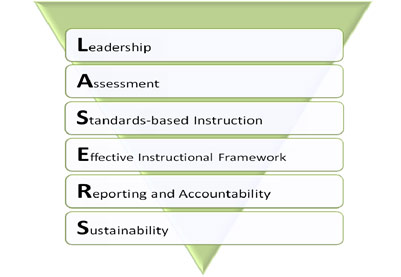In a study by Century and Levy (2002), sustainability is defined as “the ability of a program to maintain its core beliefs and values and use them to guide program adaptations to changes and pressures over time” (p. 3). You and your team will want to consider how you can sustain and increase practices that are aligned to your language and pre-literacy goals and the guidelines laid out in the TSLP.
Sustainability of practices is particularly a concern when temporary funding, like the Texas Literacy Initiative (TLI) grant, is used to support improved practices. Ideally, conversations about sustainability take place during the planning process for a grant or initiative, and they continue throughout a grant period, not just as the end of the funding is approaching. You can see examples of ways to build sustainability in Level D of each Action Step except those in the Sustainability component, which has only Levels A through C.
There are common threads throughout Level D in the Leadership, Assessment, Standards-based Instruction, Effective Instructional Framework, and Reporting and Accountability components. You will notice that some Indicators in Level D focus on establishing systems for monitoring progress toward language and pre-literacy goals and evaluating the effectiveness of your actions. Another way you are encouraged to increase sustainability is by establishing written policies and procedures to share when there are personnel changes. Professional development is a strong thread throughout the TSLP, and in Level D, you are reminded to provide professional development to new staff to ensure that all staff members have the capacity to implement the practices and skills targeted in your language and pre-literacy improvement efforts.
As this process progresses, the culture of the organization can be transformed. “The new way” becomes “the accepted way” and eventually becomes “the way we do education here in our school, district, or state” (Fixsen & Paine, 2009, p.14).

TO LEARN MORE: The U.S. Department of Education has published a series of briefs on a variety of topics concerning sustainability.
Sustainability Advanced Seminar: Facilitation Guide for District and School Leaders provides resources and tools for district and school personnel whose responsibilities include increasing reading achievement.
Implementation: Promising Practices to Sustained Results explores several approaches to implementation and offers guidance on why strong implementation is needed not only for achieving initial success, but also for sustaining improved outcomes over time.
You can find these resources, among others, here.

NEXT STEPS: Depending on your progress in implementing the TSLP, you may want to consider the following next steps:
-
As a team, complete or update your Implementation Inventory.
-
Use the six-step “TSLP Implementation Process: Working on an Action Step and, as a team, create or update a TSLP implementation plan for your school.
-
Communicate your plan with all stakeholders and involve staff in executing your plan.
-
Maintain a regular meeting schedule for your site/campus-based leadership team to evaluate progress toward goals and plan for next steps.
-
Review Level D in each Action Step and determine what systems need to be established or reviewed and what policies and procedures need further development.

